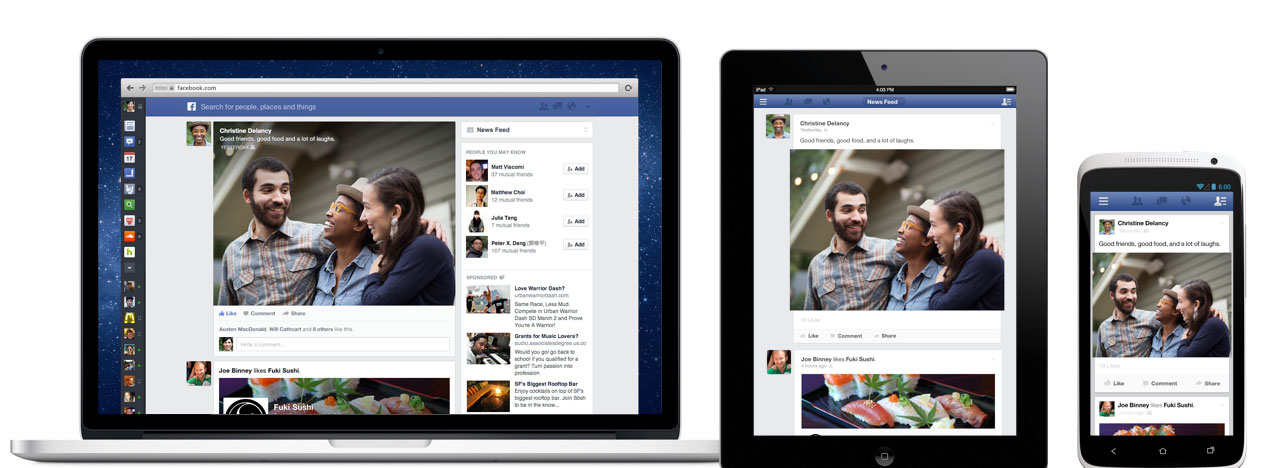Facebook Gets More Visual to Keep Its Users Engaged

The world’s biggest social network has a problem. As the Web becomes increasingly mobile and image-centric, it must figure out how to keep users on a site that wasn’t originally built with these two trends in mind.
Facebook founder and CEO Mark Zuckerberg revealed his company’s answer to the conundrum at a packed press event at the company’s headquarters on Thursday: a version of its News Feed—the custom page that shows each user activity from across his or her social circle—that’s been optimized for images and mobile gadgets. Zuckerberg described the redesigned page as a “visual, rich, and engaging” way to view status updates, photos, and “likes” posted by friends (see “Facebook Unveils a News Feed with New Look”).
Though it had more than a billion users as of late last year, there are clear signs that Facebook needs to take action to keep its users engaged. According to a recent study from the Pew Internet & American Life Project, 61 percent of current Facebook users have taken a vacation from the social network for at least several weeks, and 20 percent of people who don’t now use Facebook used to do so.
These figures threaten to grow as other, more image-centric social sites, including Pinterest, SnapChat, and Instagram (now owned by Facebook), grow in popularity. Roughly half the content in an average Facebook user’s News Feed already consists of photos and videos.
That shift probably explains today’s unveiling of a less cluttered News Feed that shows larger photos and videos and also lends itself to the kind of skimming users are likely to do on a mobile device.
“What we’ve learned from Pinterest and Instagram is the Internet today is a really visual experience,” said Lou Kerner, managing partner of the Social Internet Fund, which invests in social and Web startups. “Making the news feed more visual—they’re more following, I would say, than leading, but better late than never.”
Facebook also carried over various elements of its mobile design to the desktop version of the News Feed. This is reflected in the overall look of the main feed and in details like a little bubble that pops up to let you know there are new stories in the feed.
“It’s amazing how much more modern and clean this feels just because we’ve adapted a lot of the design principles from the phone and brought them over to the Web,” said Chris Cox, vice president of product at Facebook.
Indeed, taking design cues from what works in mobile is something that many large tech companies (such as eBay) are realizing is necessary to maintain a competitive edge.
The redesigned News Feed also lets users sort through all the content they have access to. Facebook has long filtered News Feed content with an algorithm that shows users what it thinks they most want to see. The new News Feed will continue to do this, but it also offers quick access to a variety of sub-feeds that let users more easily explore all types of content. Sub-feeds include one devoted to photos, another that just shows updates from people and things a person “follows” on Facebook, and a third that shows all activity by a person’s friends.
Somewhat surprising to some was that Facebook didn’t talk very much about how ads will feature in the new version of the News Feed. Asked if users will see more ads, and more targeted ads, Zuckerberg said Facebook is seeing more demand from advertisers but doesn’t necessarily want to push more content to the News Feed. He said that a decision about whether to place ads within the mini-feeds hasn’t been made yet but could be implemented over time.
One thing is for sure: bigger photos and videos will mean bigger, more visual ads, too (I spotted a few already this afternoon). If users stick around longer to look at status updates they may peruse these ads as well.
Rebecca Lieb, an industry analyst at Altimeter Group, says marketers are investing less in written ads online and more on visuals like photos and videos, since reading text is less practical on a smaller screen. “As people scroll through their News Feed, all of these different posts are competing for their attention. In a way, the most arresting image wins,” she says.
It may be some time before we get a good sense of how Facebook’s users like the new design, though. Facebook said the remodeled News Feed was rolled out Thursday to just a limited number of users. It will reach a larger audience as soon as it is “super polished,” Cox said.
That decision may be one of the most calculated parts of the change. In the past, users have protested sudden sweeping changes to site features. By bringing the new News Feed to users bit by bit, Facebook may be able to drum up more excitement—and convince users to spend more time on the social network when they finally get it.
Keep Reading
Most Popular
Large language models can do jaw-dropping things. But nobody knows exactly why.
And that's a problem. Figuring it out is one of the biggest scientific puzzles of our time and a crucial step towards controlling more powerful future models.
How scientists traced a mysterious covid case back to six toilets
When wastewater surveillance turns into a hunt for a single infected individual, the ethics get tricky.
The problem with plug-in hybrids? Their drivers.
Plug-in hybrids are often sold as a transition to EVs, but new data from Europe shows we’re still underestimating the emissions they produce.
Google DeepMind’s new generative model makes Super Mario–like games from scratch
Genie learns how to control games by watching hours and hours of video. It could help train next-gen robots too.
Stay connected
Get the latest updates from
MIT Technology Review
Discover special offers, top stories, upcoming events, and more.